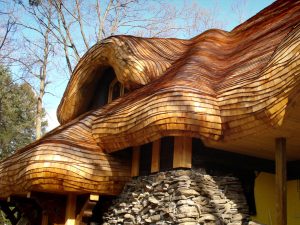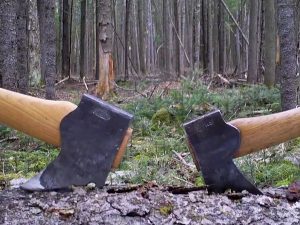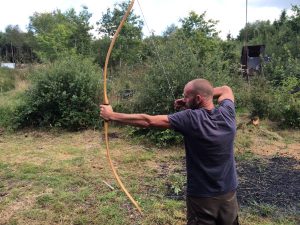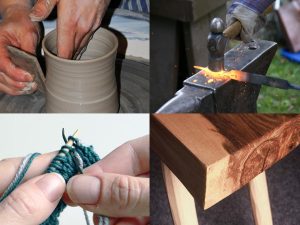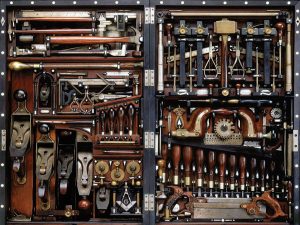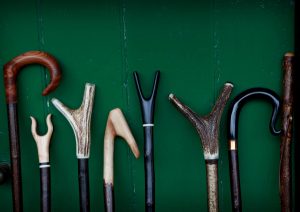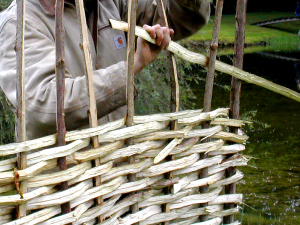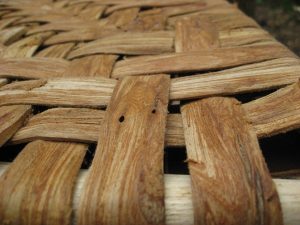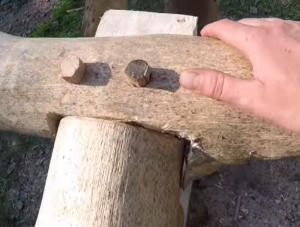Green woodworking - introduction
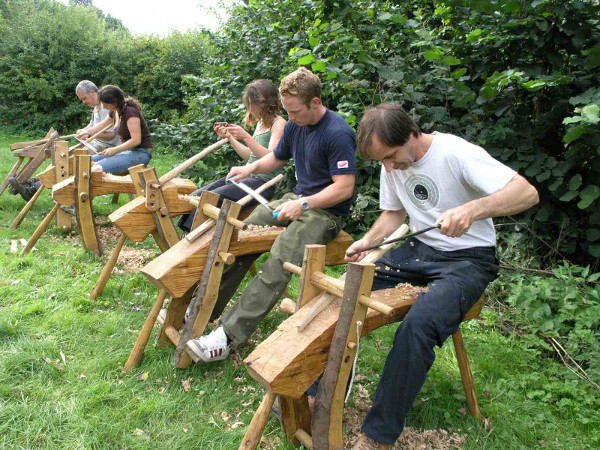
“With green woodworking there’s no need for costly materials and machinery. All you need to begin crafting is a log, an axe, and a hand knife.” – Barn the Spoon
Contents
What is green woodworking?
‘Green’ in this context refers to the working of wet or unseasoned wood that has recently been felled or harvested. Freshly cut wood contains a lot of water which will eventually evaporate, causing shrinkage. This ‘wetness’ can be of benefit in some green woodworking joints which rely on shrinkage to produce a tight fit. Wood can still be considered green for up to a year if left in a round log before being worked. Techniques for shaping green coppiced wood follow the grain, producing softer flowing surfaces – but increased strength, as the wood’s linear fibres remain intact. Green woodworking requires a different set of skills and tools to modern carpentry, as well as a closer understanding of the nature of wood and the character of different trees. Originally, all woodworking would have been green woodworking. These techniques evolved to shape unseasoned wood when it was soft and pliable, and the wood simply dried over time after it had been worked.

Once a piece of wood is seasoned, it’s no longer referred to as green. Seasoned traditionally meant planked timber air-dried for at least a year. During this time the moisture content drops below decomposition level (below 21%) and a substantial amount of shrinkage takes place. Nowadays, most timber is kiln-dried down to below 12% moisture content, and modern carpentry relies almost exclusively on supplies of milled and kiln-dried timber. Green woodworking techniques generally involve splitting and working with the grain rather than sawing through it, causing minimal distortion of the wood during shrinkage and seasoning.
Introduction to green woodwork part 1: splitting a log for green woodworking.
The techniques of green woodworking cross many disciplines, from boat and house building to expressive arts, furniture-making and home crafts. Many of our customs, expressions and works of art have been inspired by these traditions. Green oak timber framing is also enjoying a revival. This technique is mainly used for barn and house construction. Frames are assembled from large sawn or hewn timbers connected with mortise and tenon joints and fixed with wooden pegs.

What are the benefits of green woodworking?
- Green wood is soft and therefore easy to work with hand tools; this reduces the need for power tools, which are noisy, dangerous, require electricity and can cause dust-related respiratory problems.
- Work can be done outdoors in the fresh air directly after the tree is felled; working this way is healthy, and gives a sense of connectedness to the trees and to the natural environment generally.
Introduction to green woodwork part 2: using an axe.
- Most green woodworking products are made from coppiced hardwood; coppicing is the practice of cutting back trees before they reach maturity, after which they re-grow – a bit like a haircut. Trees managed in this way have been know to survive many times their normal life span. Humans have been coppicing for so long that some insects and plants have evolved to prefer this type of habitat; coppicing is a sustainable system of woodland management.
- Most general building timber now is imported softwood; green woodworking has developed around using local wood which means lower embodied energy – in other words, the amount of energy used in its harvesting, transportation and processing. For example, sawn timber has an embodied energy value of around 580kW per tonne, and if it is imported it may be 3 times this much. Brick has an embodied energy value 4 times the above figure, cement 5 times, glass 14 times, steel 24 times, aluminium 46 times and plastics 77 times. Wood that you’ve hand cut has an embodied energy rating of practically zero.

- We have very little woodland left in Britain. Most of what we do have is softwood plantation; native British broadleaf woodland supports a richer diversity of wildlife. Re-establishing economic demand for these woodlands encourages their planting and protection; every bit of wood you use from Britain may also mean less de-forestation or illegal logging elsewhere in the world.
- It’s a way of getting furniture and utensils that has a very low impact on nature.

What can I do?
You can give it a go by attending a course, and get more information from books (see resources for both). Then, if you’re serious about green woodworking, get yourself a basic collection of hand tools, plus a shave horse and pole lathe, after which you can easily start making presents, kitchenware, toys, furniture, garden structures and general fixings for the home. Your skills will improve with experience and experimentation.
Introduction to green woodwork part 3: the shavehorse.
You can make your own shave horse and pole lathe. There are plans online. Both items are what green woodworkers call a ‘third hand’. A shave horse is a leg-operated vice and a pole lathe is a leg-operated piece of kit that allows you to turn wood using hand-chisels. Both are pretty much essential for a green woodworker. With a pole lathe you can make anything round/cylindrical, like bowls, chair legs, rounders bats etc, and with a shave horse you can make anything square/flat, or with flat edges, like roof shingles, spatulas etc.

A basic toolkit to get started would include:
- a froe, for splitting wood
- a side-axe, for rough shaping-up (although you might manage with a well-sharpened axe or carving axe)
- a draw-knife, to finely tune wood on the shave horse
- a set of turning chisels to use with your pole lathe
- gouge chisels and spooning knives for carving
Introduction to green woodwork part 4: the pole lathe.
Most trees do have particular properties that lend themselves to certain uses. If you’re about to embark on your first project, cherry, birch and sycamore are good for small carved items (spoons etc.), although pretty much any hardwood will do the job. Ash is good for furniture-making as it’s so strong (and pretty), and oak or sweet chestnut are good for outdoor work as they are very durable.

It’s a useful and enjoyable craft for all ages – it’s safe for kids as it doesn’t require power tools, and it’s easy to get started as you don’t need a specialist workshop with power, extractor fans etc. If you don’t have access to woodland to get wood, try Coppice Products, where you’ll find lots of people selling wood. Look up your local foresters, and especially tree surgeons, who might well be happy to give you wood for free if you collect it.
Specialist(s)
Thanks to Adrian Leaman of Wholewoods for information.
The specialist(s) below will respond to queries on this topic. Please comment in the box at the bottom of the page.

Adrian Leaman of Wholewoods helped Ben Law to build his Woodland House in 2002, and since then has been roundwood timber framing, particularly reciprocal roof roundhouse building, and sharing woodland and woodcraft skills with people from all walks of life. He is a Forest School Leader and works with adults and teenagers on educational projects.


